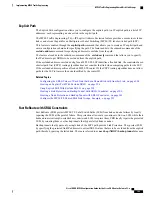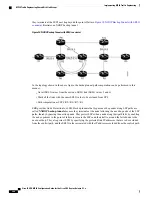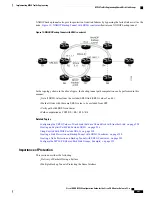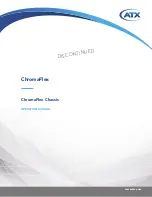
•
Whenever SRLG values are modified after tunnels are signalled, they are verified dynamically in the
next path verification cycle.
Related Topics
Configuring the SRLG Values of Each Link that has a Shared Risk with Another Link, on page 294
Creating an Explicit Path With Exclude SRLG, on page 296
Using Explicit Path With Exclude SRLG, on page 298
Creating a Link Protection on Backup Tunnel with SRLG Constraint, on page 300
Creating a Node Protection on Backup Tunnel with SRLG Constraint, on page 303
Configure the MPLS-TE Shared Risk Link Groups: Example, on page 353
MPLS TE SRLG Scale Enhancements
MPLS Traffic Engineering Shared Risk Link Groups (SRLG) feature has been enhanced to support:
•
Increase from 32 to 64 (59 for ISIS) groups.
•
Increase from 250 to 500 interfaces.
Related Topics
Configuring the SRLG Values of Each Link that has a Shared Risk with Another Link, on page 294
Creating an Explicit Path With Exclude SRLG, on page 296
Using Explicit Path With Exclude SRLG, on page 298
Creating a Link Protection on Backup Tunnel with SRLG Constraint, on page 300
Creating a Node Protection on Backup Tunnel with SRLG Constraint, on page 303
Configure the MPLS-TE Shared Risk Link Groups: Example, on page 353
Soft-Preemption
MPLS-TE preemption consists of freeing the resources of an established LSP, and assigning them to a new
LSP. The freeing of resources causes a traffic disruption to the LSP that is being preempted. Soft preemption
is an extension to the RSVP-TE protocol to minimize and even eliminate such traffic disruption over the
preempted LSP.
The soft-preemption feature attempts to preempt the LSPs in a graceful manner to minimize or eliminate
traffic loss. However, the link might be over-subscribed for a period of time.
In a network that implements soft preemption, zero traffic loss is achieved in this manner:
•
When signaling a new LSP, the ingress router indicates to all the intermediate nodes that the existing
LSP is to be softly preempted, in case its resources are needed and is to be reassigned.
•
When a given intermediate node needs to soft-preempt the existing LSP, it sends a new or special path
error (preemption pending) to the ingress router. The intermediate node does not dismantle the LSP and
maintains its state.
•
When the ingress router receives the path error (preemption pending) from the intermediate node, it
immediately starts a re-optimization that avoids the link that caused the preemption.
•
When the re-optimization is complete, the ingress router tears down the soft-preempted LSP.
Cisco IOS XR MPLS Configuration Guide for the Cisco CRS Router, Release 5.1.x
203
Implementing MPLS Traffic Engineering
Soft-Preemption







































